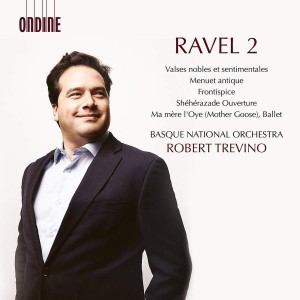
Maurice Ravel (1875-1937)
Valses nobles et sentimentales
Menuet antique
Frontispice (orch. Pierre Boulez)
Shéhérazade – Ouverture de féerie
Ma mère l’Oye
Basque National Orchestra/Robert Trevino
rec. 2021, Miramón, Donostia-San Sebastián, Spain
ONDINE ODE1416-2 [72]
On the second Ravel disc by the Basque National Orchestra and Principal Conductor Robert Trevino, two substantial works flank three shorter pieces. The programme, writes Trevino in his booklet note, “represents more the French side of Ravel’s French-Basqueness”. Their first disc – with Rapsodie espagnole and Bolero – focussed more on Ravel’s “Spanish-Basque” side and had a slightly mixed reception (review). This disc delivers quite unmixed pleasure.
The opening of Valses nobles et sentimentales is marked Modéré but Trevino puts into the first valse more impetus than usual, and it makes a lively start. The lovely second waltz Assez lent (fairly slow), after a rallentando just before fig.14 (1:00) and again at fig.18 (2:25), becomes un peu plus lent (a little slower) and p rubato. Here the musicians find exactly that Ravelian tendresse that is surely intended, with an exquisite flute solo typical of the charms of the woodwinds of this orchestra. Each waltz is similarly well characterised. When the seventh dance is reached, Trevino directs its ff passages as a giddy whirl. The Epilogue, very sensitively played, captures the sense of the dancers having departed, the ballroom still quietly echoing fragments of themes in this evanescent envoi.
There is more Ravelian magic in Ma mère l’Oye in its full ballet version. It adds to the Suite two new sections at the start and five linking interludes. This is a continuous thirty-minute score which the composer preferred to be heard even in concert, rather than the original sixteen-minute Suite. Once again, the wind players shine. The chirruping woodwinds in the newly added first tableau are a delight, as is the flute in the second tableau (the Pavane of Sleeping Beauty), and the oboe and cor anglais in Petit Poucet (Tom Thumb). Although the music is continuous, each tableau and interlude is separately tracked, so the truly indulgent listeners can encore the enchanting Fairy Garden finale, if they so wish; and they will be tempted by the fine playing and conducting, the retenu into the ravishing close perfectly judged.
The Menuet antique is orchestrated piano music, like Valses nobles et sentimentales and several other pieces that swell Ravel’s catalogue by having two versions, the monochrome and the multi-coloured. The orchestral colours of the Menuet antique were added thirty-six years after piano version, and here they sound very vivid. This minuet has little of baroque gentility about it, and its stamping rhythms are given full value by Trevino, while he brings a welcome restraint to the contrasting middle section.
Frontispice is the shortest (2:09) and strangest Ravel work, scored for two pianos, but with a stave for a fifth hand for five of its fifteen bars. Its small scale is perhaps explained by its commission by a poet friend, who published the score as a frontispiece for some verses. The layout might be explained by its likely destination as music written directly for pianola. But neither explains its avant-garde polytonality and polyrhythms, which make it difficult to recognise the composer. This orchestration by Pierre Boulez was made in 1987 for the fiftieth anniversary of Ravel’s death, and is a more palatable listen than the two-piano version.
The “fairy overture” Shéhérazade was Ravel’s first work for orchestra. It is not especially characteristic of the later master, and though enjoyable enough in this committed performance, at fourteen minutes it always feels slightly long for its substance. But it is the two main works that matter here, and they are given excellent performances. There is very good sound with a wide dynamic range and good balance. As so often, however, I would welcome a slightly more forward presence from the harp in Ravel’s orchestral music at times. The booklet notes are useful, not least in unpicking the origins of the curious Frontispice.
Roy Westbrook
Help us financially by purchasing through



















